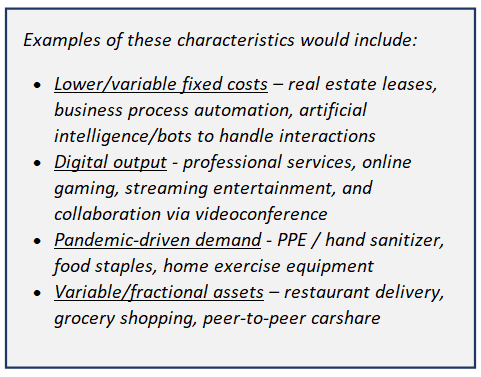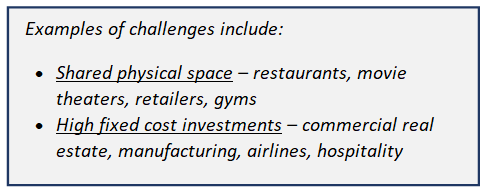
Since March of 2020 and the onset of the pandemic, companies have become more digitally woven into the fabric of their customers’, employees’, and suppliers’ lives. But, what does that mean? The sweeping global pandemic has changed the very meaning and context of business and work. This impacts how companies serve their customers and enable employees to engage through meaningful remote – and now hybrid – working models. This article explores how the pandemic has altered the digital landscape and the important lessons we have learned. It shows how organizations can develop and maintain two core principles of digital transformation: technology-based flexibility, and technology-based scalability, which enable them to quickly respond to disruptions in the marketplace and the global business environment.
When the pandemic unexpectedly struck, the response of most companies was ad-hoc, piecemeal, and reactive. A rapid response had to be cobbled together to keep business running as the world shifted toward socially distanced working models. Businesses were impacted by immediate and severe drops in demand for their products and services, coupled with scarcity of employees willing or able to work. Unpredictable logistics capabilities made shipping and receiving operations extremely challenging.
In financial terms assets that represented substantial fixed costs (e.g., facilities, equipment, etc.) were heavily underutilized, resulting in extreme financial challenges to service-associated debt and maintenance costs. Variable costs did decrease, but not necessarily by choice, as their underlying drivers (e.g., employees, shipping, inventory), which were essential to production and delivery, became scarce through the fear and uncertainty surrounding exposure to COVID-19.
Businesses needed technology solutions that allowed them to address the gaps in their value chain – both on the customer demand and workforce/product supply side – that also considered an appetite for personal risk (i.e., exposure to the virus). They also needed solutions that would provide an array of options for consumers and workers to choose from when engaging in commerce.
Looking back, we see that companies that had initiated some form of digital transformation prior to the onset of the pandemic fared better than their competition, particularly if their journey-to-date had addressed engagement and interaction with customers, vendors, and employees.
High performing businesses through the pandemic were generally characterized as:
- Having typically lower fixed costs, whether they started that way or were able to convert those costs to a more variable nature;
- Being able to deliver business output digitally;
- Experiencing abnormally high pandemic-driven demand; and
- Utilizing technology to capitalize on variable/fractional part-time repurposing of assets (whether company-owned or not) to address value chain gaps.

More challenged were companies that:
- Required most of their customers to share the same physical space;
- Were heavily invested in fixed-cost assets;
- Lagged in technology and digital experience/presence; and
- Had difficulty attracting and retaining workers and customers.

smaller businesses with limited technical skillsets, the most effective solutions to overcoming these challenges turned out to be digital services they could tap into on-demand or develop in-house, if they had the capabilities and/or deemed particular applications as mission-critical. In the case of non-mission-critical needs, these digital services could be leveraged from various providers. While not always marketed as such, many businesses turned to cloud-based options in the form of “Pick-Whatever-It-Is-You-Need”-as-a-Service, including:
- Recruiting employees (LinkedIn (News - Alert), Fiverr/Upwork, Indeed),
- Marketing and brand-building (Facebook, Google, HubSpot, Twitter, other social media),
- Order intake (Amazon, Salesforce, eBay (News - Alert)),
- Manufacturing and Design (Fast Radius, Samsara, Invoiced.com),
- Product delivery (Uber, Instacart, FedEx, UPS),
- Business management (Intuit (News - Alert), Sage, Workday), and
- Collaboration (Teams, Zoom, Miro, Lucid).
Post-pandemic, will businesses revert to pre-pandemic operating models? The consensus is, most likely, they will not, because they cannot or, rather, their employees and customers won’t let them. adoption of digital operations changed the dynamics of customer and workforce engagement and provided new expectations in experience and work/life balance. According to a 2022 State Of Remote Work report by Buffer, which surveyed 2,118 people hailing from 16 different countries, 97% of respondents said that they would like to work remotely at least some of the time.
Business can now be conducted globally with workers collaborating from multiple locations. Design and production can now be distributed to partners and gig workers, and work can be time-shifted to follow the sun, while accelerating higher quality delivery. A hyper personalized buying/user/post-transaction experience moves to the forefront of driving product success and customer retention. What was originally a necessary reaction to the pandemic (i.e., the move to digital technologies) must now become a fully vetted program focused on delivering key capabilities viewed through the prism of value to the organization.
Yet, these shifts will also create new challenges: How do businesses differentiate in an increasingly commoditized (i.e., decreasing customer/employee switching costs) world? do you build culture and redefine human connection across time and distance? How do you securely outfit remote workers with the tools they need to do their jobs productively? Can you trust that they will get the work done? How do businesses support employee work/life boundaries, reduce burnout, while also optimizing employee efficiency?
Businesses are leveraging digital technology and seeing significant social and business benefits, such as the scalability and flexibility that allows leaders to focus on the business’ defining essence – its “secret sauce.” This has led to the grand realization that the world has gone from asking “How can we work this way?” to reframing the question to ask, “Why would we not work this way?”
According to the Buffer survey:
- 61% of employees said that they had a very positive experience with remote work.
- 49% of respondents said their companies are fully remote and 56% would like to be fully remote.
- 72% of employees said their organization is planning for some form of permanent remote work going forward. Notably, this is a 46% increase compared to Buffer asking the same question in 2021.
Many countries and localities are now relaxing social distancing and other health protocols/mandates. Businesses are reopening their offices and allowing (but not necessarily requiring) employees to return to the workplace. But, prudence dictates recognizing that another COVID variant, or some other global challenge, may be awaiting us just beyond the horizon. A “digital” operating model can mitigate elements of that risk with its inherent flexibility and scalability due to its cloud-based foundation, while meeting the needs of changing workplace/career paradigms.
Digitally native companies, such as Uber, Salesforce, Fiserv, have this next-generation operating structure in their organizations’ DNA, but that doesn’t mean more “traditional” companies are excluded from reaping the benefits of digital. Any organization can – and, quite frankly, should – take a hard look at itself and boldly challenge what they do and how they do it.
We are at a tipping point in terms of business capabilities. In summary, its hallmarks are:
Scalability: rapid, low-cost adjustment of the volume of what organizations are doing with their suppliers, employees, and customers, and
Flexibility: ease and speed of pivoting what organizations are currently doing, including building new products / services, and dramatically enhancing operations.
Moving business processes to cloud-based/native solutions and applications is the key to enabling scalability and flexibility in an agile digital operating model.
One cautionary point: It is not a good idea to embark on cloud migration for the sole purpose of cutting costs. It often does not. Cloud transformation should be embarked upon with an automation mindset that enhances the ability of employees, customers, and vendors to interact. It will provide executive teams with options to rapidly flex and scale far faster than historically possible. Examples of how this can generate competitive advantage include:
- Quick, cost-effective testing of new markets/products,
- Enhanced supply chain visibility and predictability,
- Improved customer behavior and opinion insight,
- Ability to scale to meet seasonal demands,
- Predictive models to reduce inventory and working capital demands, and
- Improved asset utilization (such as service and delivery routing).
Additionally, these digital tools will capture valuable data that businesses can use to improve decision-making on how and when to flex and scale.
The reality is that, a few years ago, the business world was already venturing down this path of digital transformation. The pandemic has only accelerated the journey. Cloud-based technology can seamlessly scale and harness the flexible use of potentially disparate assets and business processes that span the entire value chain, enabling businesses to be successful while mitigating risks of future disruptions.
The following authors contributed to this article:

Kevin Corr
National Director, Business Transformation & Strategy
Neudesic, an IBM (News - Alert) Company

Erin Sanders
National Director, Business Transformation & Strategy
Neudesic, an IBM Company
Edited by Erik Linask




